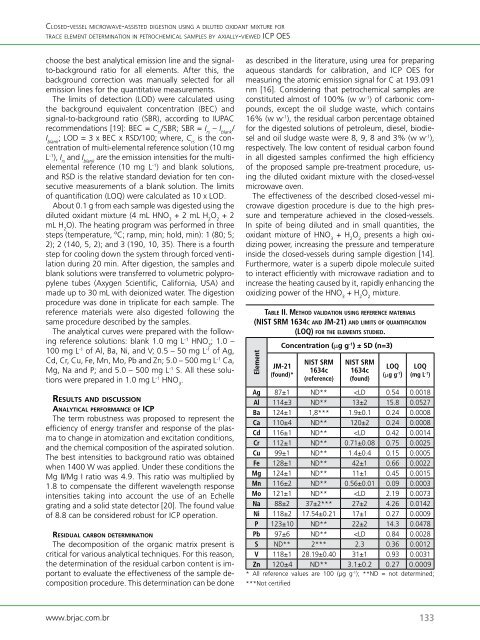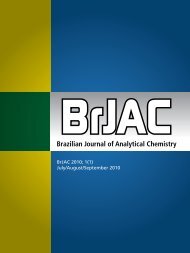Brazilian Journal of Analytical Chemistry - BRJAC - Brazilian Journal ...
Brazilian Journal of Analytical Chemistry - BRJAC - Brazilian Journal ...
Brazilian Journal of Analytical Chemistry - BRJAC - Brazilian Journal ...
Create successful ePaper yourself
Turn your PDF publications into a flip-book with our unique Google optimized e-Paper software.
Closed-vessel m iC ro w a v e-assisted digestion u s i n g a d i l u t e d o x i d a n t m i x t u r e f o r<br />
t r a C e element determination in p e t ro C h e m iC a l samples by a x i a l l y-viewed iCp oes<br />
choose the best analytical emission line and the signalto-background<br />
ratio for all elements. After this, the<br />
background correction was manually selected for all<br />
emission lines for the quantitative measurements.<br />
The limits <strong>of</strong> detection (LOD) were calculated using<br />
the background equivalent concentration (BEC) and<br />
signal-to-background ratio (SBR), according to IUPAC<br />
recommendations [19]: BEC = C rs /SBR; SBR = I rs – I blank /<br />
I blank ; LOD = 3 x BEC x RSD/100; where, C rs is the concentration<br />
<strong>of</strong> multi-elemental reference solution (10 mg<br />
L -1 ), I rs and I blank are the emission intensities for the multielemental<br />
reference (10 mg L -1 ) and blank solutions,<br />
and RSD is the relative standard deviation for ten consecutive<br />
measurements <strong>of</strong> a blank solution. The limits<br />
<strong>of</strong> quantification (LOQ) were calculated as 10 x LOD.<br />
About 0.1 g from each sample was digested using the<br />
diluted oxidant mixture (4 mL HNO 3 + 2 mL H 2 O 2 + 2<br />
mL H 2 O). The heating program was performed in three<br />
steps (temperature, ºC; ramp, min; hold, min): 1 (80; 5;<br />
2); 2 (140, 5, 2); and 3 (190, 10, 35). There is a fourth<br />
step for cooling down the system through forced ventilation<br />
during 20 min. After digestion, the samples and<br />
blank solutions were transferred to volumetric polypropylene<br />
tubes (Axygen Scientific, California, USA) and<br />
made up to 30 mL with deionized water. The digestion<br />
procedure was done in triplicate for each sample. The<br />
reference materials were also digested following the<br />
same procedure described by the samples.<br />
The analytical curves were prepared with the following<br />
reference solutions: blank 1.0 mg L -1 HNO 3 ; 1.0 –<br />
100 mg L -1 <strong>of</strong> Al, Ba, Ni, and V; 0.5 – 50 mg L -1 <strong>of</strong> Ag,<br />
Cd, Cr, Cu, Fe, Mn, Mo, Pb and Zn; 5.0 – 500 mg L -1 Ca,<br />
Mg, Na and P; and 5.0 – 500 mg L -1 S. All these solutions<br />
were prepared in 1.0 mg L -1 HNO 3 .<br />
results a n d dIscussIon<br />
an a l y t Ic a l p e r f o r m a n c e o f Icp<br />
The term robustness was proposed to represent the<br />
efficiency <strong>of</strong> energy transfer and response <strong>of</strong> the plasma<br />
to change in atomization and excitation conditions,<br />
and the chemical composition <strong>of</strong> the aspirated solution.<br />
The best intensities to background ratio was obtained<br />
when 1400 W was applied. Under these conditions the<br />
Mg II/Mg I ratio was 4.9. This ratio was multiplied by<br />
1.8 to compensate the different wavelength response<br />
intensities taking into account the use <strong>of</strong> an Echelle<br />
grating and a solid state detector [20]. The found value<br />
<strong>of</strong> 8.8 can be considered robust for ICP operation.<br />
re s Id u a l c a r b o n determInatIon<br />
The decomposition <strong>of</strong> the organic matrix present is<br />
critical for various analytical techniques. For this reason,<br />
the determination <strong>of</strong> the residual carbon content is important<br />
to evaluate the effectiveness <strong>of</strong> the sample decomposition<br />
procedure. This determination can be done<br />
www.brjac.com.br<br />
as described in the literature, using urea for preparing<br />
aqueous standards for calibration, and ICP OES for<br />
measuring the atomic emission signal for C at 193.091<br />
nm [16]. Considering that petrochemical samples are<br />
constituted almost <strong>of</strong> 100% (w w -1 ) <strong>of</strong> carbonic compounds,<br />
except the oil sludge waste, which contains<br />
16% (w w -1 ), the residual carbon percentage obtained<br />
for the digested solutions <strong>of</strong> petroleum, diesel, biodiesel<br />
and oil sludge waste were 8, 9, 8 and 3% (w w -1 ),<br />
respectively. The low content <strong>of</strong> residual carbon found<br />
in all digested samples confirmed the high efficiency<br />
<strong>of</strong> the proposed sample pre-treatment procedure, using<br />
the diluted oxidant mixture with the closed-vessel<br />
microwave oven.<br />
The effectiveness <strong>of</strong> the described closed-vessel microwave<br />
digestion procedure is due to the high pressure<br />
and temperature achieved in the closed-vessels.<br />
In spite <strong>of</strong> being diluted and in small quantities, the<br />
oxidant mixture <strong>of</strong> HNO 3 + H 2 O 2 presents a high oxidizing<br />
power, increasing the pressure and temperature<br />
inside the closed-vessels during sample digestion [14].<br />
Furthermore, water is a superb dipole molecule suited<br />
to interact efficiently with microwave radiation and to<br />
increase the heating caused by it, rapidly enhancing the<br />
oxidizing power <strong>of</strong> the HNO 3 + H 2 O 2 mixture.<br />
taBlE ii. mE t h o d validation u s i n g rEfErEnCE matErials<br />
(nist srm 1634C a n d Jm-21) a n d limits o f q u a n t i f iC a t i o n<br />
(loq) f o r thE ElEmEnts studiEd.<br />
Element<br />
Concentration (µg g -1 ) ± SD (n=3)<br />
JM-21<br />
(found)*<br />
NIST SRM<br />
1634c<br />
(reference)<br />
NIST SRM<br />
1634c<br />
(found)<br />
LOQ<br />
(µg g -1 )<br />
LOQ<br />
(mg L -1 )<br />
Ag 87±1 ND**



